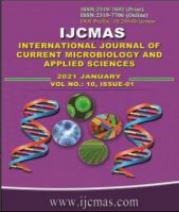


 National Academy of Agricultural Sciences (NAAS)
National Academy of Agricultural Sciences (NAAS)

|
PRINT ISSN : 2319-7692
Online ISSN : 2319-7706 Issues : 12 per year Publisher : Excellent Publishers Email : editorijcmas@gmail.com / submit@ijcmas.com Editor-in-chief: Dr.M.Prakash Index Copernicus ICV 2018: 95.39 NAAS RATING 2020: 5.38 |
with the increasing number of Pandemic Corona virus disease 2019 (COVID-19) cases, there is a need for a quick and easy method to obtain a non-invasive sample for the detection of this novel corona virus (severe acute respiratory syndrome corona virus 2; SARS-CoV-2).This study aimed to investigate the potential use of salivary samples as a non-invasive tool for the diagnosis of COVID-19. Study Period: October 2020 to November 2020.Type of Study: Prospective study. Place of study: Covid Care Centre, Tertiary Hospital Thanjavur. Specimens: A total of 60 samples of Saliva and nasopharyngeal swabs from SARI patients admitted in Covid care center Thanjavur during the outbreak of COVID-19. Real-time polymerase chain reaction (RT-PCR) was performed, and the results of the two specimens were compared. Sixty participants were enrolled in this study which included 33 males and 27 females. The median age was 32 years (IQR: 25-51 years). A positive test by either sample route (saliva/NPS) tested by qRT-PCR was considered as true positive and considered as reference standard. The 9 participants who were NPS tested negative for COVID-19, also tested negative with saliva (True negatives). Out of 44 positive cases, 42(70%) were accurately diagnosed as SARS Co-V-2 positive with saliva and 44(73%) with NPS. With saliva samples the sensitivity was 84% specificity was 90%, positive predictive value was 97.67%, negative predictive value was 52.94% and accuracy was 85%. Whereas with NPS the sensitivity was 88%, specificity was 80%, positive predictive value was 95.65%, negative predictive value was 57.14% and accuracy was 86.67%. The Cycle threshold values of both the sampling methods were comparable. Saliva was also found to be equally consistent. 70% of the participants found saliva as the preferred method of sampling.
 |
 |
 |
 |
 |